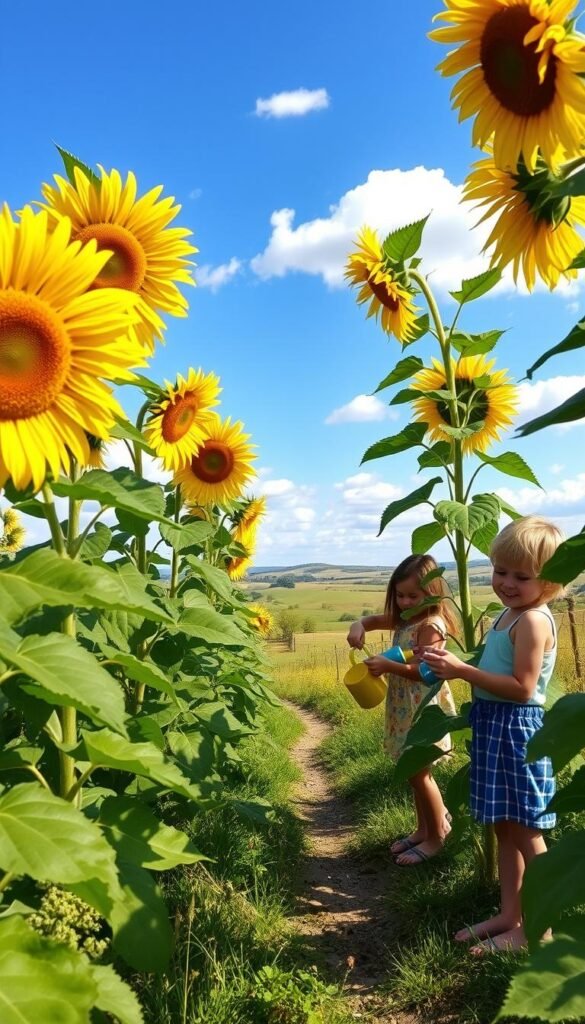Nothing sparks wonder in young minds quite like watching a tiny seed become a towering plant. Sunflowers, with their bright faces and sky-high growth, offer families an unforgettable gardening adventure. These cheerful blooms aren’t just pretty—they’re packed with science, math, and life lessons disguised as fun.
Did you know sunflower heads turn daily to follow the sun? This heliotropic dance gives kids a living example of nature’s rhythms. In just 10-14 weeks, seeds planted in late spring become summer giants taller than most adults. Fast results mean short attention spans stay engaged from first sprout to final bloom.
Beyond the wow factor, these plants teach practical skills. Measuring growth each week turns rulers into toys. Counting petals becomes math practice. When beginner-friendly blooms like marigolds or zinnias need friends, sunflowers rise as perfect companions—literally and figuratively.
Gardens become classrooms where picky eaters discover where food comes from. Studies show kids who grow veggies eat more greens. With sunflowers, even non-veggie lovers gain responsibility through watering and care. Confidence grows alongside stems as young gardeners witness their impact on living things.
Ready to start? This guide walks through every step—choosing seeds, tracking progress, and celebrating success. You’ll create memories while planting seeds of curiosity that last long after summer fades.
Understanding Sunflowers and Their Appeal for Kids

Few garden projects deliver instant rewards like these golden giants. Their magic lies in dramatic transformations – what starts as a speck in a child’s palm becomes a living skyscraper in weeks.
The Fascinating Lifecycle of Sunflowers
Watch eyes widen as seeds crack open in 7-10 days. Stems shoot up 6 inches weekly, unfurling plate-sized leaves. By week 8, buds form – nature’s countdown to the big reveal.
The final act stuns every time. A single flower head bursts open, its 1,000+ tiny blooms creating that iconic yellow crown. “It’s like fireworks made of petals!” one young gardener exclaimed.
| Variety | Height | Days to Bloom |
|---|---|---|
| Titan | 16+ feet | 90 days |
| Teddy Bear | 1 foot | 70 days |
| Solar Flash | 3 feet | 60 days |
Why Kids Love Watching Them Grow
Daily changes make sunflowers perfect for short attention spans. Monday’s knee-high plant becomes Friday’s waist-high wonder. Measuring sessions turn into math practice without textbooks.
Small hands grasp big concepts through these plants. “How does it drink?” leads to root discussions. “Why’s it facing west?” introduces photosynthesis. Every question becomes a teachable moment.
Selecting the Perfect Sunflower Variety for Your Garden

Your sunflower adventure begins with choosing the right character for your garden story. With over 70 varieties available, each offers distinct personalities through color, height, and bloom style. The key lies in matching plant traits to your space and family’s interests.
Exploring Varieties and Their Unique Traits
Giant sunflowers like ‘Mammoth’ create living jungles, stretching past 12 feet with seed-packed heads perfect for bird feeders. For multi-colored magic, ‘Autumn Beauty’ showers gardens with bronze and mahogany flowers on branching stems. Those wanting cut-friendly blooms love ‘Sunrich Gold’ – its pollen-free flowers stay vibrant in vases for weeks.
| Type | Height | Special Feature |
|---|---|---|
| Titan | 16+ ft | Record-breaking size |
| Teddy Bear | 2-3 ft | Fluffy double blooms |
| Choco Sun | 14 in | Container superstar |
Choosing Varieties Suitable for Containers and Beds
Small-space gardeners rejoice! Dwarf varieties like ‘Choco Sun’ thrive in pots, blooming cheerfully on balconies. ‘Teddy Bear’ delights young growers with manageable 3-foot stems and plush golden heads. For ground beds, branching types create floral fireworks displays, while single-stem giants deliver jaw-dropping height.
Consider your goals: snack-ready seeds, cutting garden candidates, or pure visual drama. As one parent shared, “My kids voted for ‘Mammoth’ – now they measure themselves against it weekly!” Match your pick to both your space and your crew’s curiosity.
Planting and Direct-Sowing Sunflower Seeds

The secret to sunflower success starts long before the first sprout appears. Timing and technique work together to create ideal growing conditions. Let’s dig into creating the perfect launchpad for your floral giants.
Preparing the Soil and Location
Choose a spot that basks in 6-8 hours of daily sunlight – these solar-powered plants won’t settle for less. Test drainage by pouring water on the area; if puddles linger after an hour, mix in sand or compost. Young helpers can “rainstorm test” different zones with watering cans.
Break ground deeply – 2 feet down and 3 feet wide – to accommodate those famous taproots. Blend aged manure or slow-release fertilizer 8 inches deep, turning soil into a nutrient buffet. Soil pH between 6.0-7.5 creates the Goldilocks zone for growth. Kids love crumbling earth through their fingers while hunting for worms!
Effective Sowing Techniques and Spacing
Wait until nighttime temps stay above 50°F and frost danger passed before planting. Show children how to poke finger-deep holes (1-1½ inches) – perfect for little hands. Space seeds 6 inches apart initially, using rulers or stick markers for visual guides.
Thin seedlings to 18-24 inches once they reach 6 inches tall. This planting strategy lets kids practice decision-making: “Which plant looks strongest?” Use thinned sprouts for science observations or compost lessons. Remember – crowded plants compete for sunlight like siblings sharing toys!
Caring for Growing Sunflowers Throughout the Season

Keeping your floral giants thriving requires smart care strategies. Their dramatic growth spurt demands precise watering and clever support systems. Let’s explore how to keep these solar-powered wonders healthy while turning maintenance into family fun.
Watering, Feeding, and Sunlight Requirements
Young plants thrive with targeted hydration. Water 3-4 inches from their base to encourage root spread. As stems thicken, switch to weekly deep soakings – about 2 gallons per plant. Kids love measuring water amounts using colorful pitchers.
Hold fertilizer until leaves reach dinner-plate size. A half-strength nitrogen feed every 14 days fuels vertical growth. When flower buds form, switch to tomato fertilizer for bloom power. “We call it plant protein shakes!” laughs one gardening dad.
Supporting Tall Varieties with Staking Practices
Giant varieties need backup dancers. Insert bamboo stakes when plants hit 3 feet tall. Secure stems using soft ties – old t-shirt strips work perfectly. Make it a weekly check-up game: “Is our sunflower standing straight?”
Watch for leaves drooping midday – nature’s thirst signal. Involve kids in weather tracking; they’ll learn when to water more during heatwaves. Proper care creates sturdy stems that withstand summer storms and curious squirrels alike.
Growing Sunflowers: A Kid-Favorite Project from Seed to Bloom
Gardening with sunflowers leaves lasting impressions that textbooks can’t match. These golden giants transform backyards into living labs where gardening becomes playtime with purpose. Their flexible nature welcomes first-timers – plant a few extra seeds, then let young helpers decide which sprouts stay during thinning. This hands-on sunflower preschool activity builds decision-making skills through simple choices.
What makes these flowers perfect for families? They thrive on attention but forgive missed waterings. Kids see daily changes – sprouts shooting up, leaves unfurling – creating natural excitement. Measuring stems becomes a weekly race against last month’s height marks. When blooms finally erupt, they’re not just flowers but personal achievements wearing petals.
Adapt your approach to any space. Pots on patios work for dwarf varieties, while yard corners become jungles with towering types. Through this process, children learn patience through gardening as seeds transform over weeks. The real harvest? Confidence growing alongside each sunflower, proving small efforts yield big results.






